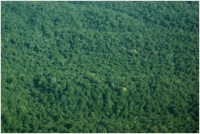
For the first time, astronomers and global change researchers are collaborating to measure changes at a global scale on our own planet, beginning with tropical forests.
"The ASTROTROP project will help global change scientists to start observing changes on planet Earth with the same rigour as astronomers observe stars," said Dr Alan Grainger from the School of Geography at the University of Leeds, who co-leads the project.
In the project, a network of European astronomers, coordinated by the Royal Observatory Edinburgh, will collaborate with a network of UK tropical forest researchers, coordinated by the University of Leeds. ASTROTROP will be launched in Edinburgh on 30-31 October at the Measuring the Planet 2013 conference.
Pan-Tropical Forest Observatory
Although earth observation satellites have collected global data for over 40 years, there is still no mechanism to convert these data into accurate global information on key aspects of planetary change, such as how quickly tropical forest areas are changing. Scientists need this information to produce reliable estimates of the resulting rates of carbon emissions and species loss.
The ASTROTROP project is intended to pave the way for a Pan-Tropical Forest Observatory that can fill this gap. It tackles the two main constraints on planetary measurement: lack of collaboration between different scientific disciplines, and technological difficulties that arise when handling 'big data'.
"The key remaining technological challenge that we need to overcome to make a Pan-Tropical Forest Observatory operational is to combine numerous spatial databases on changes in forest area, carbon and species content in different regions. Our first thought was to combine them in just one big computer database, from which scientists could download the digital maps they needed. Then we learned that astronomers had successfully tackled a similar problem in a different way." Dr Alan Grainger, School of Geography, University of Leeds
Digital maps
Astronomers needed to combine multiple digital maps showing the visible, infrared, X-ray and other features of the Universe. To meet this challenge, the Science and Technology Facilities Council (STFC) funded the development of AstroGrid virtual observatory software between 2001 and 2009. This software enables astronomers to combine multiple digital maps from different locations across the world using the web. The data is standardised so that astronomers can use a ‘mix and match’ approach from various datasets.
STFC is now funding ASTROTROP project to test the feasibility of using AstroGrid software to monitor changes in the world's tropical forests. Running the software on a powerful central computer would allow data on forest areas collected by satellites, and processed by teams of scientists across the world, to be combined with data on the distribution of species and carbon within forests, measured by hundreds of other researchers.
"It's very satisfying to be able to share experiences from very different areas. The similarities are closer than we thought. For example, the number of stars in the Milky Way is very similar to the number of trees in tropical forests on Earth." Prof. Andy Lawrence, Institute for Astronomy, University of Edinburgh, who coordinates the astronomical side of the project.
Dr Grainger concludes: “The astronomers and tropical forest researchers participating in the project are excited about how much they can learn from each other, and we are inviting other scientists to join us. The STFC's Challenge Led Applied Systems Programme (CLASP) also enables us to involve corporate partners, so that UK plc can gain a world lead in global environmental observatory technology."
Image gallery
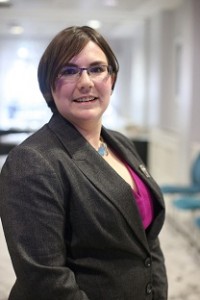
Anne Pawsey, a PhD student in the School's Soft Matter Physics group, has been awarded the 2013 Shell and Institute of Physics Very Early Career Women in Physics Award.
The award for excellence in physics as well outreach was presented at a ceremony at the Institute of Physics in London in October. Head of School Prof. Arthur Trew and Anne's supervisor Dr Paul Clegg also attended the ceremony.
“I'm delighted to receive this award and I'd like to thank my supervisor who has supported me scientifically and all the DTC students who joined in so enthusiastically with the outreach.” Anne Pawsey
Prior to the prize being awarded, Anne and the other short-listed candidates each gave a presentation about their work to an audience of the Women in Physics group committee, colleagues and friends. Anne spoke about her PhD research into colloidal particles at liquid crystal interfaces and about her role in setting up the outreach programme for the Scottish Doctoral Training Centre in Condensed Matter Physics (CM-DTC). The CM-DTC outreach programme includes a wide range of activities, from working with school science clubs to events at the National Museum of Scotland. Anne has also performed stand-up comedy about her research at the Edinburgh Fringe as part of Bright Club.
About the Award
The award is given for excellence in scientific work as well as in outreach to a woman who has gained her first degree in physics within the last five years and is an inspirational role model for women in physics. It is organised by the IOP’s Women in Physics Group (WPG) and the £1,000 prize is sponsored by Shell.
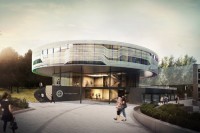
Support from the Scottish Government will help create a dedicated home for the recently established Higgs Centre for Theoretical Physics.
The Centre was created last year in Professor Higgs’ name, following the discovery of the Higgs boson, the particle that was first posited by the Professor in the early 1960s. Its researchers will create an environment in which scientists and industry players from around the world can share and develop ideas about how to use novel mathematics and computation to tackle some of the 21st Century’s great challenges.
The Higgs Centre will nurture new generations of leading physicists, whose ideas will transform fundamental physics and speed the translation of theoretical insights for commercial benefit.
In this second phase of its development, a new building will be created to house the Centre. This will be adjacent to the School of Physics & Astronomy’s base on the University’s science campus, King’s Buildings, where the Higgs Centre currently operates.
"We are delighted that the University and the Scottish Government have agreed to support us so wholeheartedly, and in particular made a commitment to create a new building to house the Centre. We see this as the second phase of a sequence of steps to secure Peter's legacy for generations to come." Prof. Richard Ball, Director of the Higgs Centre
Lasting legacy
The University of Edinburgh's Principal and Vice Chancellor, Professor Sir Timothy O'Shea, talks about how the Scottish and Westminster governments will support the project.
"Mike Russell, the Cabinet Secretary for Education, has shown a huge commitment to the University and its research and has offered warm congratulations to Professor Higgs and the University, not just on the Nobel Prize, but on these plans to create a lasting legacy from the prize." Professor Sir Timothy O'Shea, Principal, University of Edinburgh
"The Nobel Prize awarded to Peter Higgs earlier this week is a further reflection of the excellent research at Edinburgh and I have invited the University to bid to the Science & Technology Facilities Council for support for the Higgs Centre." David Willetts, UK Minister for Universities and Science
Image gallery
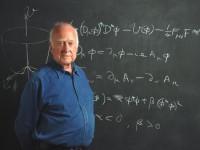
The University of Edinburgh has welcomed the award of a Nobel Prize in Physics to Peter Higgs, Emeritus Professor of Theoretical Physics.
The Nobel Prize in Physics was awarded jointly to Professor Higgs and Professor Francois Englert for the theoretical discovery of a mechanism that contributes to our understanding of the origin of mass subatomic particles and which recently was confirmed through the discovery of the predicted fundamental particle by the ATLAS and CMS experiments at CERN's Large Hadron Collider.
The Royal Swedish Academy of Sciences’ award to Professor Higgs recognises his outstanding contribution to the theoretical work that led to the prediction of the Higgs boson particle.
Scientists at CERN recently confirmed the existence of the particle, which was first postulated by Professor Higgs in 1964, when he was a young lecturer at Edinburgh.
The Higgs boson enables other fundamental particles to acquire their mass. Its discovery represents a major step in our understanding of the physical Universe.
“I am overwhelmed to receive this award and thank the Royal Swedish Academy. I would also like to congratulate all those who have contributed to the discovery of this new particle and to thank my family, friends and colleagues for their support. I hope this recognition of fundamental science will help raise awareness of the value of blue-sky research.” Prof. Peter Higgs, Emeritus Professor of Theoretical Physics, University of Edinburgh
“We are delighted at the news of this Nobel Prize award and congratulate Professor Peter Higgs on his achievement. The discovery of the Higgs particle will underpin the next generation of physics research, and this accolade is worthy recognition of its significance. Professor Higgs’ work will continue to inspire scientists at Edinburgh and beyond.” Prof. Sir Timothy O’Shea, Principal of the University of Edinburgh
"I would like to congratulate Peter and note how excited everyone in the School of Physics & Astronomy has been by him winning the Nobel Prize in Physics.
"His seminal work has not only given us deep insights into the workings of the Universe but it has also attracted a generation of young people to fundamental science. The search for the Higgs boson has created a worldwide interest in science not seen since the Moon landings - and that can only be good for civilisation." Prof. Arthur Trew, Head of the School of Physics & Astronomy
"On behalf of the Higgs Centre I would like to be among the first to congratulate Peter on receiving the ultimate accolade. While many theorists attempt to predict new physics, only a very few see their predictions actually come true! Peter’s prediction of the scalar boson discovered recently at CERN must rank among the most spectacular of all time, with profound implications for our understanding of the fundamental origin of mass." Prof. Richard Ball, Director of the Higgs Centre
"The awarding of the Nobel Prize for Physics to Peter Higgs and Francois Englert is fantastic news and thoroughly deserved for their fundamental contribution to particle physics. The Atlas team at Edinburgh, who contributed to the discovery of the Higgs boson last year, offer their congratulations and will no doubt offer a toast to the winners later in the day!" Dr Victoria Martin, Institute for Particle and Nuclear Physics, School of Physics & Astronomy
"On behalf of the College of Science and Engineering, I would like to congratulate Peter on his outstanding achievement and hope that it will serve as an inspiration to all our up and coming young scientists - both faculty and students alike." Prof. Lesley Yellowlees, Head of College of Science & Engineering
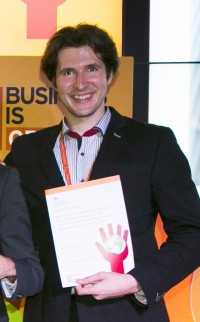
School graduate Flaviu Cipcigan fought off stiff opposition to be awarded a prize at a ‘Dragon’s Den’ style competition during the UK Trade & Investment (UKTI) Entrepreneurs’ Festival in Manchester. Flaviu was part of the ‘FiTogether’ team, which comprised participants from six countries and five continents.
FiTogether’s innovative concept aspires to develop an interactive app which will instantly connect like-minded fitness enthusiasts to make fitness more fun, social and effective. The team’s impressive skills secured them the Best Pitch prize, which includes a two-hour mentoring session with the Business Growth Hub/Enterprise Lab to help them develop their own ideas.
“Winning this award has given us all great confidence in our entrepreneurial ability. Not only was this competition a great opportunity to work as a team with people from all over the world, it allowed us to each develop our business acumen too.” Flaviu Cipcigan
Flaviu is one of the School's industry-supported graduate students. He works with The National Physical Laboratory and IBM Research in the US.
Entrepreneurial support for students and recent graduates
The international enterprise competition was held to mark the launch of The Sirius Programme. Spearheaded by UK Trade & Investment (UKTI), The Sirius Programme is a pioneering scheme to bring the world’s best entrepreneurial talent to the UK.
The 12-month start-up support and acceleration package is open to students and recent graduates with an early-stage business idea or business plan. Successful applicants receive a full range of support including investment, a place in one of the world’s best business accelerator programmes, mentoring and logistical help with relocating to the UK. Places will be allocated each month between October 2013 and January 2014, and the deadline for entries for November’s intake is 31 October 2013.
Nick Baird, Chief Executive of UKTI praised Flaviu on his achievement:
“I congratulate Flaviu on winning this award. The calibre of all the entrants from the Festival was superb, but Flaviu and his team had the edge across the board. It is great to hear that they will be applying for the Sirius Programme as this is be one of the most comprehensive start-up support packages offered globally, and the best in Europe. The quality of the participants at the Festival highlighted the potential and enthusiasm of these young entrepreneurs and we look forward to supporting entrepreneurs like them as they establish their business ventures in the UK.”
Image gallery
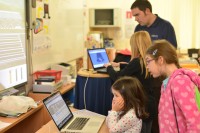
EPCC, the supercomputing centre based in the School, took part in Bang Goes the Borders, a free science festival held in St Mary's Primary School in Melrose. EPCC's Mario Antonioletti reviews the day.
This was my first time at Bang Goes The Borders, but my fellow EPCC'ers Iain Bethune and Terry Sloan were old hands, both having done it last year. We set up four stands in a classroom we were allocated, with the first overseen by Terry who ran two exercises showing the benefits of using parallelism to solve problems.
Parallelism games
Terry’s first demonstration asked volunteers to sort balls according to colour. A single person, usually a child, is asked to see how many balls they can sort in a minute, then the task is repeated with more than one person. In nearly all cases the task can be done more quickly with more people, ergo you can use multiple processors to solve a problem faster. The ball-sorting usually works very well as it gets the naturally competitive nature of kids going.
There was also a card-sorting demonstrator, which is a little bit more involved as it requires coordination between the "processors" so is more suitable for a slightly older age group.
Hardware
Having demonstrated the benefit of parallelism, I showed attendees a number of processor boards of previous machines that have been hosted by EPCC - there was a Thinking Machines CM-200 board, a Cray T3E board (which was liquid-cooled), a Cray XT board and, to compare them with something that might be more familiar and found at home, the insides of a Dell desktop.
There was some interest among the audience in all of this, but perhaps not so much for the younger age group who were more attracted by the aesthetics of the component arrangement, liked poking about the exposed electronics or trying to lift the Cray T3E board, and were fascinated by its heaviness.
The hope was that having experienced the benefit of working in parallel, actually seeing the boards with multiple processors would link the two experiences together.
A third desk had a rolling presentation of the types of problems that are typically run on such massively parallel systems - from climate modelling and computational biochemistry to fluid dynamics and cosmology!
Close to this was the freebies desk which was the second most popular spot, second only to the dinosaur racing.
Dino racing
By far the biggest crowd puller for us was the dinosaur racing, with a mass of people surrounding Iain at the stand. This was the second outing for this Virtual Palaeontology demo: on the EPCC blog you can read about its British Science Festival 2013 (BSF13) debut and about EPCC's presence at BSF13. A number of improvements and fixes were done post-BSF13, which further enhanced the activity. The demo was run off a node on HECToR so people were also able to use a supercomputer. Many kids came back several times during the day to try to improve on their first dinosaur design.
It is difficult to determine how many people saw our stands, although the organisers estimated that numbers were up 20-40% over last year, with over a thousand people circulating through the entire event. Certainly we must have given several hundred their first hands-on experience of supercomputing! It was a long and exhausting day, but we hope that some of the young people who visited our classroom will go on to do science in later life and, who knows, may even come to work at EPCC.
You can find out more about EPCC's work, including its outreach activities, on the EPCC blog.
Photography by Mario Antonioletti and Keith Morgan.
Image gallery

The seven-week course, entitled The Discovery of the Higgs Boson, describes the scientific advancements that led to the theoretical prediction in 1964, the building of the Large Hadron Collider and the detection of the boson. It will also highlight the cross-fertilisation between theory and experiment in particle physics during the past, and explore some of the implications for the future.
The course, which is organised by the School's Luigi Del Debbio and Christos Leonidopoulos, will feature interviews with Prof. Higgs and filmed lectures by a team of world-class physicists at the Higgs Centre for Theoretical Physics. Students can then debate what they have seen by using dedicated online discussion spaces, as well as via social media.
"I am very pleased that Peter’s incredible work will now be available to a worldwide audience of learners to analyse and discuss. Peter’s research has provided us with profound insight into the building blocks of the Universe and this course will allow anyone with a computer and access to the web to take part in the exciting and revolutionary times that we live in." Prof. Arthur Trew, Head of School for Physics & Astronomy
“There is tremendous interest among the general public in Higgs and his boson. The Higgs MOOC gives us at the Higgs Centre the opportunity to reach a wide international audience, and hopefully convey the beauty of the theoretical ideas, the excitement of the discovery, and the possible implications for our understanding of the Universe.” Prof. Richard Ball, Director of the Higgs Centre
The University of Edinburgh is offering the course as its first Massive Open Online Course (MOOC) via the FutureLearn platform, a partnership of 23 leading universities, along with the British Museum, British Council and British Library, which offers learners the opportunity to access high-quality courses for free.
The Higgs boson
Prof. Higgs developed his theory of the particle that bears his name when he was a researcher at Edinburgh in the early 1960s. Since then, the Higgs boson has formed a crucial strand of particle physics theory.
In July 2012, scientists at the European Organization for Nuclear Research (CERN), including many from Edinburgh, announced results which indicated the existence of the Higgs boson. In March 2013, CERN said that analysis of more data confirmed even more strongly that the new particle is indeed the Higgs boson.
Online learning at Edinburgh
The University of Edinburgh has led the way in online learning and was the first university in the UK to offer MOOCs via the Coursera platform, which brings together universities from around the world to offer free Higher Education-standard courses across a diverse range of subject areas.
During the first round of Edinburgh’s courses, more than 300,000 people signed up to study from a selection of six MOOCs.
By joining the FutureLearn network, Edinburgh will be able to offer MOOCs to an even greater number of learners around the world.
Edinburgh will be offering a selection of new and existing MOOCs in late 2013 and throughout 2014, via the Coursera and FutureLearn platforms.
The Higgs MOOC offers a hugely exciting opportunity for learners to experience university-standard courses, at no cost to themselves. Over the next 12 months, we will be announcing details of more than a dozen MOOCs, across a range of subjects, reinforcing Edinburgh’s position as a world-leader in online learning. Prof. Sir Timothy O’Shea, Principal of the University of Edinburgh
Quality assured
Edinburgh’s MOOCs have been developed by senior academic staff and their content is checked using the same quality assurance methods as for our other courses. The courses do not offer a credit towards entrance to the University of Edinburgh, but are taught to the same standards as our other online courses.
Online learning at Edinburgh
MOOCs complement the University’s substantial offering of high-quality online postgraduate programmes. We offer Postgraduate Certificate, Postgraduate Diploma or Masters qualifications across a broad range of subject areas. These involve the same level of work overall as our on-campus programmes, and the qualification awarded is of equal value.
Our online learning courses also offer flexible exit routes, allowing you to shape your academic journey to suit your needs.

We're here to help all our new students ('Freshers') who will be joining us this month.
Freshers' Welcome meeting
Tuesday 10th September, 10am-12pm, Lecture Theatre A, James Clerk Maxwell Building, King's Buildings.
Our Freshers' Welcome meeting aims to answer all your questions about studying at the School of Physics & Astronomy. It is open to all students who are starting a Physics degree with us, whether you are entering First Year or taking direct entry into Second Year.
Visiting Students' meeting
Tuesday 10th September, 2pm-4pm, Room 4316, James Clerk Maxwell Building, King's Buildings.
This meeting is especially for those of you who are here as 'visiting students' (with us for 6 months or a whole year).
Both meetings are designed to give Freshers all the information they need, for example the name of your personal tutor and the structure of your degree.
Please try to make the most of the many activities during your first week. It's a fantastic opportunity to get to know lots of people, join student societies and maybe join a club for a sport you would have never imagined yourself doing!
An international team of researchers from the UK Centre for Astrobiology (UKCA) and Carnegie Institute of Washington went to Disko Island, Greenland, in August to explore its potential for deep carbon research.
Their aim was to provide new, well-characterised material for research projects focused on the deep carbon cycle, representing an international effort to provide samples and data from remote and fascinating locations.
Disko rocks
Greenland is well known as a geological wonderland. Disko Island off the west coast of Greenland is no exception, and it offers a unique opportunity to investigate carbon sources and fluxes within reservoirs ranging from the Earth’s mantle to the deep subsurface biosphere.
The basalts here contain unusual carbon species that are rare on the Earth’s surface. Their formation has remained enigmatic for decades, yet can shed light on the role and speciation of carbon in the Earth’s mantle. Disko Island is also home to thousands of geographically-isolated deep thermal springs. These provide a ‘window’ into the subsurface biosphere for the study of microbiological communities dwelling within the Earth’s crust, and particularly how they fix and cycle carbon.
Exploring new environments
The field-team of four (Claire Cousins and PhD students Mark Fox-Powell and Casey Bryce from Edinburgh, and Sami Mikhail from the Carnegie Institute of Washington) explored and sampled environments ranging from subglacial sediments to radioactive thermal springs. They also collected geological samples ranging from run-of-the-mill basalts to those containing unusual reduced carbon phases and native metals.
The samples will eventually be catalogued and listed on the System for Earth Sample Registration, and made available to the international community under the “DCO Collection”, as well as providing material for on-going research here in the UKCA and the Physics of Living Matter group.
Find out more
More details of this expedition, including an expedition blog, can be found on Claire's blog.
This expedition was funded by the Deep Carbon Observatory (DCO) and UK Centre for Astrobiology (UKCA), and was led by Claire Cousins (UKCA) in collaboration with Sami Mikhail (CiW), Adrian Jones (UCL), Charles Cockell (UKCA), and Andrew Steele (CiW).
Image gallery
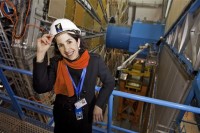
Fabiola Gianotti, former spokesperson of the Atlas collaboration who co-announced the discovery of the Higgs boson at CERN in July last year, has been appointed an Honorary Professor in the School of Physics & Astronomy.
"I am very honoured and pleased to be appointed Honorary Professor at this prestigious School, which has such great historical traditions and excellent theoretical and experimental groups. I look forward to collaborating with the Edinburgh physicists, in particular with the very strong and lively ATLAS group". Fabiola Gianotti
Fabiola will be associated with the School's Experimental Particle Physics Group, which carries out research at both the ATLAS and LHCb experiments at the LHC. She will work with Edinburgh staff and PhD students based at CERN and visit the School for specialist lectures.
Fabiola is a member of the International Advisory Committee of the Higgs Centre for Theoretical Physics at the University of Edinburgh, and has been a colleague of Peter Higgs himself for some time.
"We are delighted that Fabiola is now an Honorary Professor in our research group. Fabiola is very enthusiastic and we look forward to seeing her here in Edinburgh in the autumn." Peter Clarke, Edinburgh Particle Physics Research Group
"We are very excited Fabiola will be joining our ATLAS research team as a visiting professor. Her vast knowledge of the ATLAS experiment will be a great asset to our research on the Higgs boson and in searching for any new phenomena the LHC may reveal." Victoria Martin, Edinburgh Particle Physics Research Group
Distinguished career
Fabiola has had a distinguished career in particle physics. She gained her PhD in 1989 from the University of Milan. As a post-doctoral researcher her first project was the R&D for what later became the ATLAS experiment at the Large Hadron Collider (LHC). In 1996 she joined the ALEPH experiment at the LEP-II (Large Electron Positron) collider where she worked upon the search for evidence of supersymmetric particles, which are candidates for dark matter.
She became a CERN Fellow and then a member of the CERN staff in 1996. After a period of detector development she became involved in the many physics preparation studies needed in advance of the first proton beams at the LHC as well as work on the liquid Argon calorimeter. She was elected “Physics Coordinator” of ATLAS from 1999-2003, Deputy Spokesperson from 2004-2009, and then in 2009 she was elected as the Spokesperson of ATLAS, a position she held until she stepped down in March 2013. This position is one of the most senior leadership positions in the field of experimental particle physics, where she was responsible for a collaboration of nearly 3000 physicists from over 170 international Institutions. Her role has of course been central to the most recent high point of the LHC programme, the discovery of the Higgs boson.
Prizes
In 2012 she was awarded the title of "Grande Ufficiale al merito della Repubblica" by the Italian President Giorgio Napolitano. She received the Special Fundamental Physics Prize (funded by the Milner Foundation), awarded jointly to the ATLAS and CMS Spokespersons for their leadership that led to the discovery of the Higgs Boson, and was elected as a member of the Italian “Accademia Nazionale dei Lincei” in 2012.
In 2013 Fabiola was awarded the Italian “Nonino Prize” and the Enrico Fermi prize of the Italian Physical Society.

